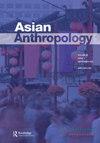中国瓷都的漂泊:景德镇个体工艺工人的自我实现与另类寻求
Q2 Social Sciences
引用次数: 1
摘要
随着中国瓷器之都景德镇的政府工厂的衰落和关闭,最近一波被称为“井漂族”的流动个体手工业工人面临着一个两难的选择:是遵循独立的工艺实践并保持脆弱,还是雇佣工人,自动化一些步骤,偷工减料以赚取更多的钱。最近政府主导的景德镇再开发计划正在引入空间重组和对制造过程的新规定。居民们对这些政府主导的计划有不同的看法,并表明这些变化加剧了个体手工业工人工作的不稳定性。通过参与观察、深度访谈和日记,我还报道了应对这些转变的不断变化的社会动态,这些转变发生在个体工艺工人、当地工艺社区、国家支持的企业资本家和国家相遇的地方。通过将个体工艺工人置于这样一个不断变化的背景中,以及在他们的工艺社区中,自力更生和无忧无虑的生活方式叙事盛行,我发现,尽管他们的工作、行业和城市中存在脆弱性和不稳定性,但个体工艺工人可以自力更生、自我组织和相互支持。这表明了一种自给自足的替代生活方式的可能性,这种生活方式与中国新自由主义消费主义社会和国家主导的关于景德镇的文艺复兴叙事相似。本文章由计算机程序翻译,如有差异,请以英文原文为准。
Drifting in China’s porcelain capital: self-realization and alternative-seeking of the self-employed craft workers in Jingdezhen
Abstract Following the decline and closure of government factories in Jingdezhen, the Chinese capital of porcelain, a recent wave of migrant self-employed craft workers known as “Jing drifters” (jingpiao 景漂) has faced a dilemma: whether to follow independent craft practices and remain vulnerable, or hire workers, automate some steps, and cut corners to make more money. Recent government-led redevelopment plans in Jingdezhen are introducing spatial reconfigurations and a new regulation of the manufacturing process. Residents have diverse opinions on these government-led plans and show that these changes have exacerbated the instability in the work of the self-employed craft workers. Drawing on participant observation, in-depth interviews, and diaries, I also report a changing social dynamic in response to these transformations, which takes place where the individual craft workers, the local craft community, the state-endorsed enterprise capitalists, and the state meet. By contextualizing the individual craft workers in such a changing context as well as in their craft communities where a self-reliant and carefree lifestyle narrative is prevalent, I find that the self-employed craft workers can be self-reliant, self-organized, and mutually supportive despite the vulnerability and instability in their work and in the industry and city. This suggests the possibility of a self-sufficient alternative lifestyle that parallels that of the Chinese neo-liberal consumerist society and of the state-led renaissance narrative about Jingdezhen.
求助全文
通过发布文献求助,成功后即可免费获取论文全文。
去求助
来源期刊

Asian anthropology
Social Sciences-Anthropology
CiteScore
1.60
自引率
0.00%
发文量
25
期刊介绍:
Asian Anthropology seeks to bring interesting and exciting new anthropological research on Asia to a global audience. Until recently, anthropologists writing on a range of Asian topics in English but seeking a global audience have had to depend largely on Western-based journals to publish their works. Given the increasing number of indigenous anthropologists and anthropologists based in Asia, as well as the increasing interest in Asia among anthropologists everywhere, it is important to have an anthropology journal that is refereed on a global basis but that is editorially Asian-based. Asian Anthropology is editorially based in Hong Kong, Taiwan, and Japan, but welcomes contributions from anthropologists and anthropology-related scholars throughout the world with an interest in Asia, especially East Asia as well as Southeast and South Asia. While the language of the journal is English, we also seek original works translated into English, which will facilitate greater participation and scholarly exchange. The journal will provide a forum for anthropologists working on Asia, in the broadest sense of the term "Asia". We seek your general support through submissions, subscriptions, and comments.
 求助内容:
求助内容: 应助结果提醒方式:
应助结果提醒方式:


